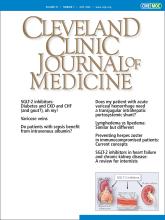
Hyperglycemia is the hallmark characteristic of diabetes mellitus. Blood glucose and hemoglobin A1c are guideline-driven markers useful for diagnosis and monitoring treatment. But blood glucose is but 1 part of this systemic metabolic disease that also has inflammatory components. “Successful” aggressive control of blood sugar has had limited success in preventing the onset and progression of cardiovascular and renal damage. Many of our patients still struggle with ischemic heart disease, heart failure, peripheral arterial disease, and kidney disease. There have been several new US Food and Drug Administration (FDA)–approved medications to treat type 2 diabetes, some of which use unique physiologically targeted mechanisms to lower blood glucose.
The FDA drug approval process has mandated that increased attention be given to studying the effects of potential diabetes drugs on the systemic components of diabetes mellitus, not just on their hypoglycemic activity. The initial focus was on excluding unanticipated detrimental cardiovascular effects. Studies were large, with prospectively planned collection of detailed cardiovascular and renal data, and cardiovascular events were carefully adjudicated. As a result, it was demonstrated that some of the newer drugs capable of lowering the glucose by novel mechanisms were not only cardiac safe, but somewhat surprisingly were able to reduce several cardiac (and renal) morbidities. Jaswaney et al1 in this issue of the Journal discuss the use of the sodium-glucose cotransporter 2 (SGLT-2) inhibitors in patients with heart failure and chronic kidney disease, including those without type 2 diabetes.
These drugs are effective adjuncts in lowering glucose and A1c levels. Designed to work by inducing glucosuria with anticipated reductions in circulating insulin levels in patients with type 2 diabetes, there was reason to think that they could reduce some of the metabolic components of type 2 diabetes that might be exacerbated by hyperinsulinemia. It was a welcome surprise (and a bit confusing) to many of us not practicing primarily in the diabetes arena that the clinical trials for multiple drugs in this class demonstrated efficacy in decreasing heart failure admissions (for patients with reduced as well as maintained ejection fraction), all-cause and cardiovascular mortality, and progression of chronic kidney disease. And, these benefits were also found in patients without type 2 diabetes. Perhaps also surprisingly, the incidences of myocardial infarction and stroke apparently were not significantly reduced,2 raising further questions about mechanism of action. But it seems quite unlikely that these benefits are from the induced glucosuria and the resultant relative hypoglycemia.
So how does gout enter into this discussion? Gout is a prototypic autoinflammatory disease that may occur in patients with long-standing hyperuricemia (generally defined as a level above urate’s estimated in vivo saturation point of 6.8 mg/dL), which can result in the deposition of monosodium urate in and around joints and sometimes in organs, including the kidney. The physiologic basis for hyperuricemia in most patients is inefficient intestinal and renal excretion, the latter being due to excess reabsorption of uric acid in the proximal tubules. Although it is the dramatic acute gout flare that gets attention from patients and clinicians alike, patients with gout and hyperuricemia share many metabolic comorbidities with patients who have diabetes mellitus: chronic kidney disease, cardiovascular disease, metabolic dysfunction–associated steatotic liver disease, and hypertension. The frequent presence of these comorbidities (as well as diabetes mellitus) in patients with gout often creates therapeutic challenges when treating acute flares as well as hyperuricemia. Like the glucose control and cardiovascular disease story, successful treatment of hyperuricemia has not been rigorously demonstrated to beneficially impact the comorbidities of cardiovascular and kidney disease.
Nonetheless, it was a welcome observation that all the SGLT-2 inhibitors reduce the serum urate level, perhaps as much as 1.5 mg/dL,3 providing another therapeutic option to treat hyperuricemia and gout. Exploring the clinical and biological features of this effect has led to other interesting observations.4
The SGLT-2 inhibitors lower the serum urate rapidly, and this effect persists as long as the drug is taken. The major, but likely not only,4 mechanism of action is to stimulate uricosuria. The hypouricemic effect is somewhat less in patients with type 2 diabetes, perhaps because the hyperinsulinemia is associated with increased expression of URAT1, the urate transporter primarily responsible for urate reabsorption in the proximal tubule (which may counteract the uricosuric effect of the SGLT-2-active drugs). More relevant to clinical practice, prospective studies with controls as well as observational studies have demonstrated that the SGLT-2-targeted drugs decrease the gout flare rate.5,6 These drugs are effective in the presence or absence of xanthine oxidase inhibitors like allopurinol.
A provocative observation has been that the decreased incidence of gout flares can be demonstrated fairly soon after initiation of treatment. This is in contradiction to the frequently observed increase in gout “mobilization flares” that accompanies the initiation of traditional urate-lowering drugs such as allopurinol or probenecid. That the SGLT-2 inhibitors don’t trigger mobilization flares6 suggests that they may also exert an anti-inflammatory effect, functionally akin to the prophylactic effect of colchicine on decreasing these early gout flares. Anti-inflammatory effects of SGLT-2 inhibitors have been demonstrated in separate experimental studies,7 and perhaps it is their anti-inflammatory effects on cytokine generation and macrophage polarization8 that explain not only their anti-gout activity, but also their beneficial effects on some of the heretofore treatment-resistant cardiovascular aspects of diabetes that were not successfully impacted by other glucose-lowering therapies.9 Perhaps it is the multipronged anti-inflammatory activities of these drugs that account for their diverse beneficial effects. Lowering the blood glucose may be just an extra benefit.
- Copyright © 2024 The Cleveland Clinic Foundation. All Rights Reserved.






